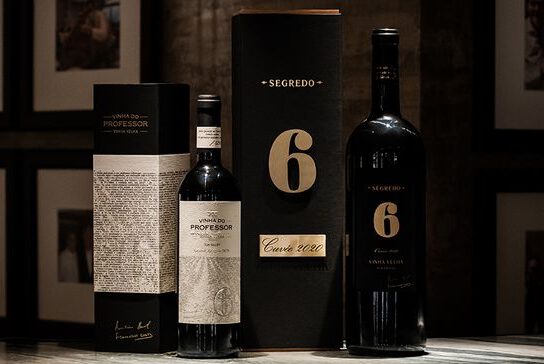Costa Boal and Francisco Costa have just launched a new edition of Segredo 6, from the 2019 harvest. One of Portugal’s best red wines.
There’s a good reason to paraphrase the great Gabriel Alves and his memorable line about “the best goalkeeper in the world, probably even in Europe”. That’s because Francisco Costa is the eternal Costinha, and 6 is the number he wore on his shirt. “A number that has accompanied me in my greatest achievements,” he says, from FêQuêPê to the National Team and now to wine – a long-held dream of which he is an acknowledged connoisseur and avowed lover. It was at the table that his friendship with producer António Costa Boal was forged.
The secret is that it is less and less, as it becomes known and appreciated here and abroad, especially in Brazil, winning prizes and medals.
It’s a wine rooted in a very special vineyard – already 70 years old – but guaranteed to bring great joy in the future. It’s a faithful portrait of its terroir, full of contrasts, on the nose and in the mouth. Surprising and modern in style, it has an elegance that we rarely associate with the region of Trás-os-Montes.
2 CC, the name of the company that brings together producer Costa Boal (Douro, Trás-os-Montes and Alentejo) and Costinha, is also betting on large formats with this wine – a rarity in Portugal, being sold almost exclusively in liter and a half Magnum bottles and with options up to 15 liters. Very exclusive, there are only 475 bottles in this vintage, 400 of 1.5 liters and 50 of 5 liters, plus 25 of 15 liters, for 600, 1,800 and 8,000 euros respectively. Of the latter, more than a dozen have already been sold. 20% of the production, however, has already been purchased by Gold Club members before the official launch. A club of connoisseurs and collectors set up precisely for these wines.
A Secret revealed at Salazar’s table
Segredo 6 was presented at Maria Rita, a restaurant in an old manor house in the village of Romeu, near Mirandela, at a huge table that was apparently a favorite of António Oliveira Salazar whenever he visited Trás-os-Montes. If he came for the Bacalhau à Romeu and the Chocolate Mousse, we can’t blame him.
As for the wine, 2021 was “the harvest that put us to the test the most,” explains Paulo Nunes, the winemaker. Not because of the work involved, as he admits, “the old vines do a lot of the work for us”, but because it was an important year for consolidating the brand and its consistency. With only three editions – 2019, 2020 and 2021 – it was essential to confirm the quality of previous years.
After three years, they also know the vineyard and its behavior better, which has allowed them to avoid some excesses: “In the first vinification we extracted more than we needed, perhaps out of fear, but now we realize that we don’t need to go that far, and this latest wine has more freshness and elegance. The vineyard has taught us that”.
The Professor’s Vineyard – because it once belonged to a professor from Mirandela – is now 70 years old and covers around 4.5 hectares of schist and quartz soils. The vines, without trellises, “fall” naturally with the weight of age. Located very close to Costa Boal’s other vineyards in the region, it has more than 30 different grape varieties, including Touriga Nacional, Touriga Franca, Tinta Roriz, Tinta Amarela, Alicante Bouschet and Bastardo, among others, including some white varieties such as Fernão Pires.
In this amalgam, we have differences of 2 and 3 weeks in the ripening points, as is the case with Bastardo and Tinta Amarela, so although “it wasn’t a lot of work”, as Paulo Nunes humbly admitted, they were forced to make some difficult decisions: “The big challenge was to find the moment when the whole vineyard is balanced,” explains the winemaker, twice considered the best of the year in Portugal. “It’s clear that this wine thrives on imbalances. We feel the warmth of the grapes harvested a few days after the ideal point, with more sugar and alcohol, and on the other hand, the freshness and acidic richness of the still early grapes. The beauty of this wine lies in this imbalance between ripe and greener grapes. If you like, it’s in the balance of these imbalances that the harmony of this wine lies.”
Paulo Nunes is not a fan of making different passes through the vineyard to try to pick the grapes at points closer to the ideal. “Making single-vineyard wines in a vineyard like this is a total mistake,” he says. “This diversity is so rich that I have to look for it, to keep it in the bottle. The wines have to have some incoherence, so that they can cause surprise. Wines that are too perfect are monochordic, and perfection is a very boring thing.”
Throughout the process, great care was taken to round out the tannins, with a very pronounced rusticity at the start, as is typical of the region. That’s why it was decided to age the wine for 16 months in new French oak barrels. New wood, because it has a more immediate effect on the wine, and in barrels rather than larger ones, because it was feared that the tannins might “dry out” rather than soften as a result of a longer ageing period. They also chose to ask the cooperages to deliver barrels designed specifically for this wine, in an original bespoke barrel option.
They say that three heads are better than one, and Segredo 6 seems to confirm this maxim, with António Boal also highlighting the high ageing potential of these wines, with “margins of progression of 30, 40, 50 years for sure”.
The best Cabernet-Sauvignon wines in Portugal
The ultimate guide to Portuguese wine


[…] Secret 6: A vineyard, a winemaker, a producer, a soccer player […]